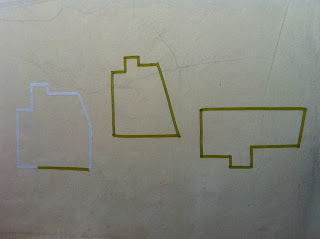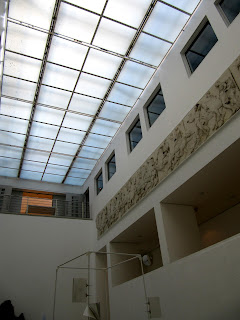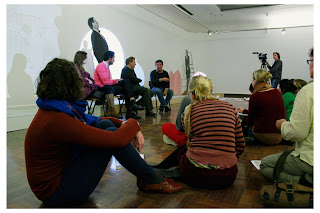I am sitting in a week. 1
I am sitting in a week. 1
gallery space which is also a void 2 : a passage to other levels of the institution. Hockney Gallery, Royal College of Art, London.
A passage in writing.
Passage through Educational systems: Critical Writing in Art and Design Program RCA, in the case of the writers involved.
Sculptural Marble passage above the gallery space: A passage giving a historical account of a happening from antiquity, documenting an event passed.
It is apt that John Dummett should set up his ‘writing hut’ 3 in this space to open up discourse on the directions which a previous happening has led him in. 4 In this previous collaboration a group of writers in residence were invited to react to An Art event - Art leading to writing.
Heaving steps passing. Pages turn, scraping paper. Seagulls squawk. 5
Here we, the artists, have been invited to react to An Event. 6 Artist’s reacting to writing. Paradoxically this has let me to want to make visual work, or audio as the case may be, and this has left me wondering about the difference, isn’t it all art anyway?
Dummett’s work brings a particular physicality into writing. Not so much the performance of writing but in the exposure of the organic working out of thoughts. The many pathways in which knowledge is subsumed. The giving of a thought by a space (space in which social relations take place); the working out- the kneading through of the thoughts as if they were objects, in that space.
Comparisons can be made of Dummett's work with Brian Dillon’s text I am Sitting In a Room, Published by Cabinet 24 hour Book series 2011, a project in which a number of writers each are invited to produce a book in 24 hours. Dillon chose to conduct his writing in situ, in Cabinets Gallery Space in Brooklyn NYC, which was open to the public throughout the performance. However Dummonds work feels like a wholly less singularly involved activity then the ‘I’ in a room. It is instead reflecting the actual nature of the writer reacting to the world. In the Hockney Gallery we saw Dummond’s attempt at opening up the processes of thought: The movement around the thinking space; the taking of thoughts out of the head and reassembling them again in a line. That is writing. This opening up of the process of thought ultimately is more interesting and more giving up of its mysteries than an end product, inspiring a true collaboration: an interaction leading to another interaction and the by-product - knowledge.
Brain Dillion in his conversation with Jane Rendell and Sally O Reilly in the RCA on the 27th of March, under the title of Writing in Situ, Site writing; wonders if the tendency to want to open up the writing process to the user (viewer/reader) is not to insist Narcissist importance of the performative central figure of the writer but a desire to collaborate with the user. This notion seems defunct considering the collaborators in the writing of Brian Dillon’s ‘I am sitting in a room’ preformed more as support system, tools even, in the writing, less as influencing collaborators; as if one were collaborating with a pen. A pen has no agency. It cannot react unpredictably, it cannot react as a collaborator, not even as an environment does, redirecting your thoughts. Interesting also is that Dillion talks of having found a Place to write, eventually he was able to retreat into his thoughts, and was able to create the distance from his environment and his spectators to continue writing in a highly charged environment, much as a runner does. It seems to have been a sort of writhing marathon.
Being out of place is a very productive situation in which to write. To ignore the desire to want to find the perfect isolated situation in which to write is very seductive however writing has a sense of contiguity7, not actually going to a particular predesigned place mentally or bodily but working with whatever happens to land next to what. Writing is a thought process, a collaboration with the innumerable experiences which lead to knowledge, as with art.
A man fixes the fence outside the window the next garden up. He uses an electric drill, the sound is distracting. Now he ties back up the washing line to the fencing and in doing so straightens the fence again.
Here the writer finds herself out of Place and writing first in 9 Talbot square, now in the kitchen of her flat, later in the library, later again her bedroom; Out of Place as an Artist writing.8
Being out of place is a mind-set .But it is not just in the private nesting places where writing is done that I am referring to here, but the fringes between the subject matter studied. The artist is frequently the itinerant scholar. Jack of all trades, never on your own turf always collecting knowledge to be used for personal expression, but in this there lies a problem, a tendency to simply skim over, not deeply understanding a subject field before making connections with others and moving on. Thankfully however it is within these spaces of collaboration, the most mongrel of connections can father invention.
1. Here the writer is referencing the writing in Situ discussion with Brian Dillon, Sally O Reilly and Jane Rendell, RCA. London 27/03/2012. In particular with Dillon’s reflections on Site Writing in his text 'I am Sitting in a Room' Cabinet Books.2011.
2 The trace of an event. Audio recording, Hockney Gallery. Sinead Bligh 2012. Click on title to play track.
3. In reference to Heiddegger’s hut, a secluded site grounded in the countryside in which the philosopher wrote.
4: An Action of Words was a Writers in residence parallel project to A Cut A Scratch A Score: A Comic Opera in Three Parts by David Barnett, Sam Belinfante and Bruce Mclean at the Cooper Gallery in October 2011.
5: Observations marked in Blue indicate disruptions to the writers train of thought whist in the library
6: An Event is a collaboration with An Action of Words, the Cooper Gallery’s off site project at the Royal College of Art, London by the critical writer Ajay Hothi and the artists and critical writers John Dummett and Christina Manning Lebek.
7.Sally O Reilly and Jane Rendal in the discussion Writing in Situ, describe the formulation of writing as having a form of contiguity, with space also being a contributing element. Here the writer agrees and believes this also demonstrates the way in which knowledge in general is subsumed.
8:Observations marked in Red indicate disruptions to the writers train of thought whilst in her flat.
2 The trace of an event. Audio recording, Hockney Gallery. Sinead Bligh 2012. Click on title to play track.
3. In reference to Heiddegger’s hut, a secluded site grounded in the countryside in which the philosopher wrote.
4: An Action of Words was a Writers in residence parallel project to A Cut A Scratch A Score: A Comic Opera in Three Parts by David Barnett, Sam Belinfante and Bruce Mclean at the Cooper Gallery in October 2011.
5: Observations marked in Blue indicate disruptions to the writers train of thought whist in the library
6: An Event is a collaboration with An Action of Words, the Cooper Gallery’s off site project at the Royal College of Art, London by the critical writer Ajay Hothi and the artists and critical writers John Dummett and Christina Manning Lebek.
7.Sally O Reilly and Jane Rendal in the discussion Writing in Situ, describe the formulation of writing as having a form of contiguity, with space also being a contributing element. Here the writer agrees and believes this also demonstrates the way in which knowledge in general is subsumed.
7.Sally O Reilly and Jane Rendal in the discussion Writing in Situ, describe the formulation of writing as having a form of contiguity, with space also being a contributing element. Here the writer agrees and believes this also demonstrates the way in which knowledge in general is subsumed.
8:Observations marked in Red indicate disruptions to the writers train of thought whilst in her flat.










































.jpg)







